How to make an air-water heat pump: device diagrams and self-assembly
In connection with the regular increase in the cost of coolants, alternative heating methods are becoming popular. For example, a practical air-water heat pump that uses air energy to heat. Installation does not require expensive consumables, easy to use, safe.
Due to the considerable cost of the factory assembly of the unit, many have an interest in the independent construction of this system. We will tell you what a home foreman will need to make a homemade heat pump. Here you will find out what technical equipment should be stocked up.
The content of the article:
- Features of the air-water thermal system
- Air-to-water heat pump construction
- Outdoor unit assembly
- Unit with heat exchanger-evaporator
- Compressor Installation Rules
- Design of storage capacity (capacitor)
- Connection of the external unit to the evaporator
- Evaporator, compressor and tank connection
- Installation Management System Implementation
- Calculation of the power of the air-water heat pump
- Homemade Installation Service
- Conclusions and useful video on the topic
Features of the air-water thermal system
The heat pump, which this article is devoted to, in contrast to other modifications of such a device (in particular, water-water and soil-water), has several advantages:
- saves electricity;
- the installation will not require large-scale earthwork, drilling, obtaining special permits;
- if you connect the system to solar panels, you can ensure its full autonomy.
A significant advantage of a thermal system that extracts wind energy and transfers it to water is one hundred percent environmental safety.
Before proceeding with the design of the pump, it is necessary to find out in which cases the system is most effective and when its use is impractical.
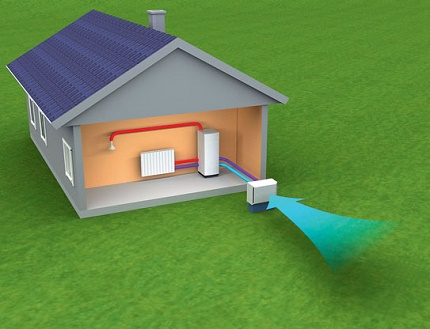
Application and work specifics
The heat pump works productively exclusively in the temperature range from -5 to +7 degrees.At an air temperature of +7, the system will generate more heat than necessary, and at a value below -5 it is not enough for heating. This is due to the fact that the concentrated freon in the structure boils at a temperature of -55 degrees.
Theoretically, the system can generate heat even in a 30-degree frost, but it will not be enough for heating, because the heat output directly depends on the difference between the boiling point of the refrigerant and the air temperature.
Therefore, this system will not work for residents of the northern regions where cold weather occurs earlier, and in the houses of the southern regions it can effectively serve several cold months.
If standard batteries are installed in the room, the heat pump will work less efficiently. Best of all, the air-water device is combined with convectors and other radiators with a large area, as well as floor heating systems, "Warm walls" of the water type.
Also, the room itself should be well insulated from the outside, have built-in multi-chamber windows that provide better thermal insulation than ordinary wooden or plastic.

Homemade Heat pump able to effectively heat homes up to 100 square meters. m and guaranteed to give a power of 5 kW. It should be understood that freon cannot be poured sufficiently high-quality into a structure created in domestic conditions, therefore, one should expect its boiling point to -22 degrees.
The home assembly device is ideal for supplying heat to the garage, greenhouse, utility rooms, small private pool etc. The system is usually used as additional heating.
Electric boiler or other traditional equipment for the heating season will be required in any case. During severe frosts (-15-30 degrees), it is recommended to turn off the heat pump in order to avoid wasting electricity, because during this period its efficiency is not more than 10%.
The principle of the system
The working substance in the design is air. Through the outdoor unit, which is installed on the street, oxygen is piped to the evaporator, where it interacts with the refrigerant.
Freon becomes gaseous under the influence of temperature (since it boils at -55 degrees) and in a heated state it enters the compressor under pressure. The device compresses the gas, thereby increasing its temperature.
Hot Freon enters the circuit of the storage tank (condenser), where heat is transferred to water, which can later be used to organize heating and FGP. In the condenser, freon loses only part of its heat, and is still in a gaseous state.
Passing through the choke, the refrigerant is sprayed, as a result of which its temperature drops. Freon becomes liquid and in this form passes into the evaporator. The cycle repeats.
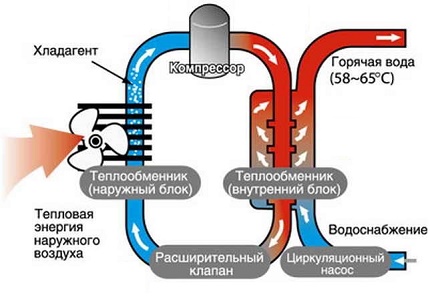
Those who wish to build on their own Heat pump from waste materials and old equipment, for example, from an old refrigerator, the information described in the article we recommend will help.
Air-to-water heat pump construction
The heat pump system consists of four main elements:
- outdoor unit;
- heat exchanger-evaporator capacities;
- unit for compressor;
- storage capacity (capacitor).
Consider the design features of each of the blocks.
Outdoor unit assembly
To create an external block you will need:
- Housing. A block from a split system, a washing machine, other overall equipment is traditionally suitable, sometimes it is built independently by welding metal elements. It is important to treat the metal with powder-type anti-corrosion paint after assembly.
- Fan. The product can be borrowed from the old work air conditioning systems or purchase separately.
The fan model should have wide plastic blades and, preferably, with a detachable motor, in order to be able to connect it to the sensor.

In the outdoor unit, you can install the evaporator and auxiliary elements for its operation, but it is more advisable to place these parts in a separate case.
Install the outdoor unit at a distance of 2-10 m from the house. It is important to build a foundation under it and put a canopy to protect the structure from precipitation. It is also necessary to fix the grille in front of the fan to avoid dirt, debris, leaves from entering the fan blades and pipes.
In addition, it is desirable to install heaters that protect the sidewalls and panels from icing. In this case, additional heating of the housing is not required. The place to install the unit must be well ventilated, away from sources of open flame.
Unit with heat exchanger-evaporator
The evaporator can be purchased ready-made using the services of suppliers on the network, or created independently. To do this, you need an 80-liter tank and copper wire with a diameter of 10 mm and a thickness of at least 1 mm.
The length is calculated individually taking into account the required power. For a 5 kW device, you can take 10 m. In the evaporator, heating and circulation of freon will occur, as well as contact with air.
To create a heat exchanger, you need to design a coil. For this, the wire is wrapped around a thick-walled pipe with a diameter not exceeding the width of the tank. It is important to leave slices protruding beyond the height of the housing. They will be needed to connect the coil with other elements of the system - the compressor and the storage tank.

2 fittings for connecting pipelines are cut into the body, two connectors for the wire exit are created. The compounds are sealed. Fasten the finished structure using L-shaped brackets.
It is recommended to additionally install a defrost relay on the evaporator, since air will be circulating in the tank, the temperature of which is negative.In this case, condensation accumulating in the system can cause the evaporator to freeze. Also, in order to exclude the formation of moisture, a filter drier can be introduced into the system.
Compressor Installation Rules
To install the compressor, you will need a separate housing with sound and vibration isolation, since almost all modifications of the device are noisy during operation. You can take a used compressor from under a refrigerator, an air conditioner, or purchase a new model.
The following types of compressors are suitable for heat pumps:
- Rotary compressors are the most inexpensive, but have a number of disadvantages - they make noise, have low efficiency and last 8-10 years.
- Spiral modifications are installed in all modern models of air conditioners, refrigerators. They are durable (15-20 years), noiseless, efficient, but have a high cost.
- Piston models are mainly installed on industrial refrigerators. Products have good efficiency, durable (15-20 years), but extremely noisy and expensive.
For a heat pump, a single-phase compressor must be selected. Before buying, it is important to find out what type of freon the device works with. It is advisable to purchase a model running on R22, preferably on R422. It is easier to work with a refrigerant of this type than with any other type of freon.
The compressor is connected by tubes to the evaporator and condenser unit. Thanks to the device, freon increases its temperature.
Design of storage capacity (capacitor)
To make a condenser, you need a casing from under a 100-liter boiler or any other stainless tank of the same volume. A coil made of a copper tube is also needed. On a 5 kW pump, you can take a 12-meter wire. Hot freon will pass through the coil tube, due to which the water is heated.
Step # 1: Creating a Coil
For the manufacture of a coil, you need a copper wire with a diameter of at least 26 mm and a wall thickness of 1 mm. It must be wound on a pipe having a smaller cross section than the tank.
The height of the spiral must match the height of the casing. It is important to leave the pipe outlets outside the tank in order to be able to connect the coil with the evaporator and compressor.
Step # 2: preparing the case
To install the coil, the tank must be cut. Above and below, you need to create holes for the exits of the copper wire, as well as cut additional compartments for the installation of 2 fittings, one of which is designed to exit the water, and the other to enter it. After the procedures done, the tank must be sealed.
The heat exchanger-compressor can be purchased separately in the form of a finished design. Using a factory-assembled device, you can increase the power and efficiency of the installation.
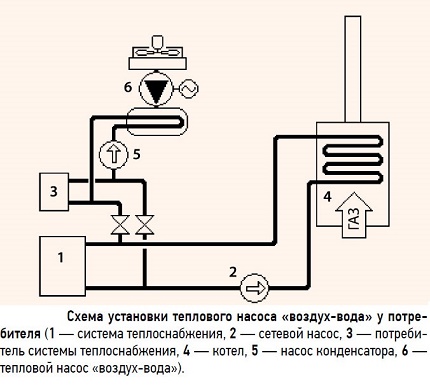
Connection of the external unit to the evaporator
To connect the outdoor unit and the evaporator, 2 polyethylene pipes will be required PND 32. Air will pass through one pipe, and exit through another.
Pipes can be buried in the ground, after adding any sand material to the ditch, or left on the surface if the outer casing is located near the house.
Evaporator, compressor and tank connection
Freon circulates in this system. To connect the coils with compressor and throttle, it is necessary to contact specialists in refrigeration equipment. It will be difficult for a person who does not have experience in soldering work, even with tools and materials, to correctly combine all the elements into one system to ensure the construction works.
Moreover, many additional materials will be required - tubes of different diameters, various modifications drain tapsvalves for air etching, safety valves, as well as clips for pipes, clamps, pipe cutters for cutting sections of the pipeline.
Other specialized devices that are available in any workshop for repairing refrigerators and air conditioners will be needed.
High-quality injection of freon is also carried out using special equipment. Therefore, to combine heat exchangers, a compressor and a throttle into a working system, it is more convenient and profitable to turn to professionals.
Installation Management System Implementation
To monitor the pressure and temperature of freon, you can use a board with a display from under any air conditioner. In the process of soldering work with the help of specialists, the design can be correctly implemented in the installation.
It is also possible to connect a special device - a fan rotation sensor. It regulates the speed of rotation of the blades, and also automates the speed of the freon circulation pump.
Additionally, you can set a timer, electric starterdevice protecting the compressor from overheating. All of these parts can be purchased at repair shops or the spare parts market.
Calculation of the power of the air-water heat pump
For heating rooms with an area of 100 square meters. m need a larger heat pump. The required power of the installation can be calculated approximately using the table:
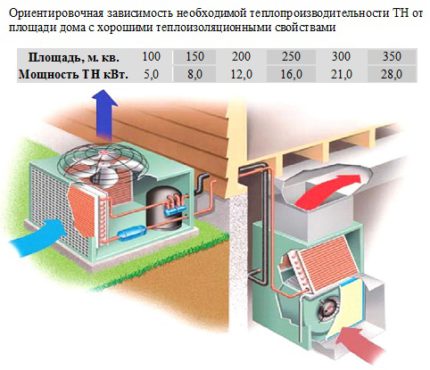
To determine what power the compressor should have, which diameters should be used, and other important data when designing an air-water heat pump, you need to turn to one of the following methods:
- Use online calculators posted on the websites of manufacturers of heat exchangers.
- Apply software Coolpack 1,46, Copeland.
- Invite a specialist who will make the necessary measurements and calculations.
Condenser coil area (PZK) can be calculated by the formula:
PZK = M / 0.8DT,
where M is the unit power in kW; 0.8 - coefficient of thermal conductivity in contact with water and copper; DT is the temperature difference between the incoming and outgoing air in the system.
The parameters of the heat pump above are suitable for rooms up to 100 square meters. meters. The power of the installation is 5 kW. If you purchase special heat exchangers, it is quite possible to increase the capacity of the installation up to 10-15 kW.
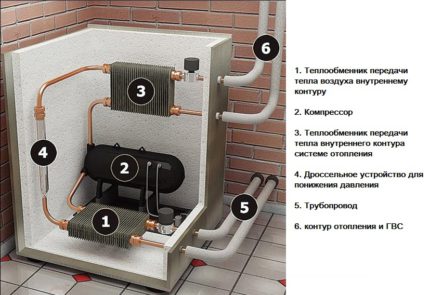
Homemade Installation Service
For high-quality operation, the heat pump needs additional maintenance. If you use the device in winter (given that there is no additional heating installed in the case), then the unit will have to be heated periodically, since an ice crust will form on its surface.
It is also necessary periodically:
- Clean the fan blades of debris - leaves, dust, dirt, snow, etc.
- Lubricate the compressor according to its instructions.
- Change the oil in the compressor and fan.
In addition, for the normal functioning of the system, it is necessary to regularly check the integrity of the copper pipeline, power cable supplying the compressor, fan and other devices.
Conclusions and useful video on the topic
The following video will familiarize you with the principle of operation and the design of a heat pump that processes wind energy:
A home-made air-water heat pump is one of the most efficient and low-cost devices for additional heating of homes. Anyone can make and install this system.
Please write comments in the block below. Perhaps you have interesting information and photos on the topic of the article? Ask questions, share your own opinions and tips useful for website visitors.

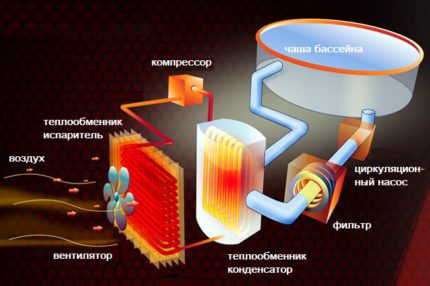
 DIY geothermal heat pump for home heating: device, design, self-assembly
DIY geothermal heat pump for home heating: device, design, self-assembly  Air-to-air heat pump: principle of operation, device, selection and calculations
Air-to-air heat pump: principle of operation, device, selection and calculations 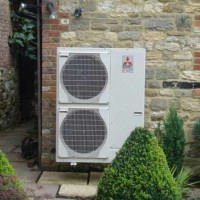 How to make a heat pump for heating a house with your own hands: the principle of operation and assembly scheme
How to make a heat pump for heating a house with your own hands: the principle of operation and assembly scheme  Water-water heat pump: device, principle of operation, rules for arranging heating on its basis
Water-water heat pump: device, principle of operation, rules for arranging heating on its basis 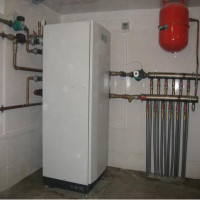 How to make a heat pump with your own hands from an old refrigerator: drawings, instructions and assembly tips
How to make a heat pump with your own hands from an old refrigerator: drawings, instructions and assembly tips  Frenett heat pump: device and principle of operation + can you assemble it yourself?
Frenett heat pump: device and principle of operation + can you assemble it yourself?  How much does it cost to connect gas to a private house: the price of organizing gas supply
How much does it cost to connect gas to a private house: the price of organizing gas supply  The best washing machines with dryer: model rating and customer tips
The best washing machines with dryer: model rating and customer tips  What is the color temperature of light and the nuances of choosing the temperature of the lamps to suit your needs
What is the color temperature of light and the nuances of choosing the temperature of the lamps to suit your needs  Replacement of a geyser in an apartment: replacement paperwork + basic norms and requirements
Replacement of a geyser in an apartment: replacement paperwork + basic norms and requirements